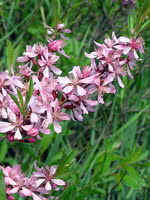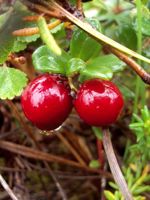Mon-Fri 9am - 5pm Mountain time
Russian Almond vs Small Cranberry
Prunus tenella
Vaccinium oxycoccos
CUSTOM GROW
Russian Almond is a low maintenance, short, slightly suckering shrub. It is covered with attractive, bright pink flowers in early spring before its foliage emerges.
This hardy species forms dense thickets attracts wildlife. Russian Almond prefers full sun and well-drained soils, but can tolerate moist soils.
The nuts it produces are quite attractive but very small. They are bitter and possibly toxic in large quantities.
Check out our YouTube channel video of the Russian Almond here.
Small Cranberry is a native evergreen groundcover found in bogs, fens, and wet meadows. It produces delicate pink flowers that attract a variety of pollinators, including bees, and it serves as both a nectar source and host plant for the Bog Fritillary (Boloria eunomia) butterfly. By late summer, the plant bears deep red berries that are eaten by both wildlife and people. With their high pectin content, the berries are well-suited for making jams and jellies.
Often creeping among sphagnum moss, Small Cranberry thrives in cold, acidic, and nutrient-poor soils (pH 2.9–4.7), making it well adapted to northern wetland environments. With its woody stems, it is technically classified as a shrub and often described as a subshrub or dwarf shrub. It is also valuable for wetland restoration and naturalisation projects.
Note: We use Small Cranberry for Vaccinium oxycoccos. This species is also known by many other common names, including Bog Cranberry, Small Bog Cranberry, and others. Please confirm the scientific name to ensure you are ordering the correct plant.

